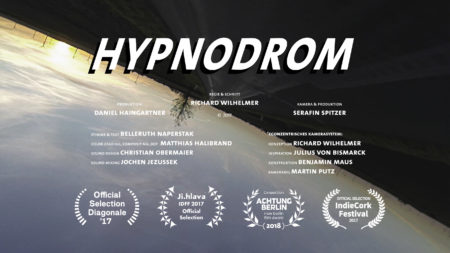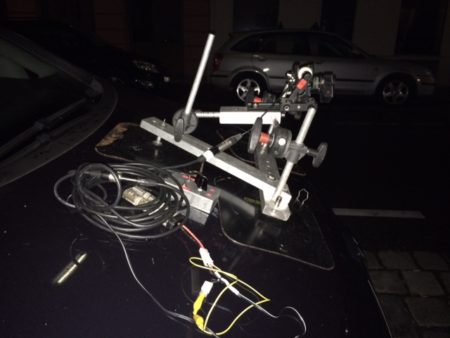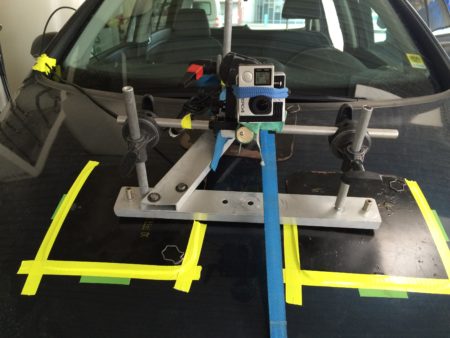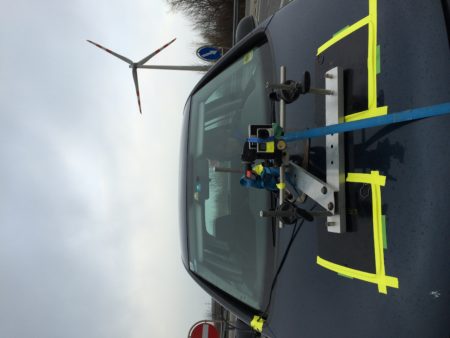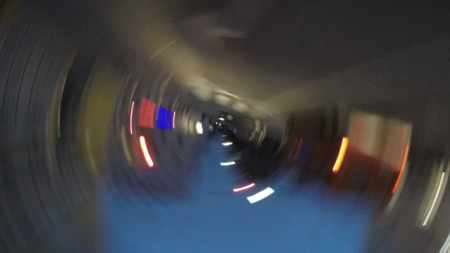Hypnodrom
Kurzfilm, 2017 / 5 Min / AT (HD)
Distributed by sixpackfilm
Festivals:
2019:
– Int. Kurzfilmfestival Rengensburg (DE)
– Tromso International Film Festival (NOR)
2018:
– Filmfest Dresden (DE)
– Flatpack Film Festival (UK)
– Achtung Berlin! New Berlin Film Award (DE)
– Cinema Next – on Tour / (AUT)
– Rooftop Films – N.Y.C. (USA)
– Milano Film Festival (ITA)
– NDU International Film Festival 2018 (LBN)
2017:
– Diagonale – Festival of Austrian Film / Competition / (AUT/Graz)
– Izola Film Festival / (SVN)
– Brooklyn 17 – Imagine Science Films (USA)
– Indie Cork / Competition (IRL)
– Cinema Next – Young Austrian Cinema / (AUT/Vienna)
– YOUKI International Youth Media Festival / Opening Program / (AUT/Wels)
– 21st Ji.hlava International Documentary Film Festival / Competition (ROU)
Synopsis:
Der Mensch als ein sich fortwährend um sich selbst drehendes ‘Ich’. Unter der Anleitung von Belleruth Naparstek, einer Pionierin auf dem Feld der imaginativen Psychotherapie, wird die Technik der „Guided Imagery“ zur selbstreflexiven Gebrauchsanweisung für das Erlebnis des ‚Medium Film’. Ein kinematografischer Blick durch die ‚egozentrische Kamera’ als Hommage an das Kino als Ort der Kontemplation und Trance.
Kurzbeschreibung:
Eine Fahrt durch die Dämmerung, eine einsame Landstraße entlang. Noch ist die Perspektive des Films an jene des Autos gekoppelt. Kaum hat man jedoch den Blick justiert und sich auf die Bewegung eingestellt, beginnt das Bild, langsam zunächst, in der horizontalen Achse zu rotieren. Tatsächlich ist rasch die Analogie zum Propeller da, der an Geschwindigkeit gewinnt; immer schneller wechseln die Hell-Dunkel-Kontraste einander ab, bis das Auge nicht mehr nachkommt. Die Landschaft, in der Bauten, ein paar Bäume vorüberfliegen, gerinnt zum abstrakten Mandala.
Richard Wilhelmers Hypnodrom ist ganz auf diesen die Sinne berauschenden Effekt zugeschnitten, der mit einer speziell dafür entwickelten Drehvorrichtung für die Kamera (Benjamin Maus/Martin Putz) verwirklicht wurde. Das Straßenbild dient nur als Matrix für eine Attraktion, welche die Land- wie hübsch fluoreszierende Stadtfahrten in eine sich frenetisch drehende Spirale verwandelt – ähnlich den “Rotoreliefs”, die schon Marcel Duchamps für sein animiertes Anémic Cinema in den 1920er-Jahren zum Kreiseln brachte. Oder wie eine beschleunigte Variante der Kippbilder, die schon Michael Snows Landvermessung per Roboterarm in La Région Central (1971) erzeugte.
Wilhelmer bietet aber noch eine andere Lesart an, die sich seiner Liebe für Science-Fiction verdankt: Eine Frauenstimme aus dem Off gibt zu sphärischen Keyboardklängen eine quasi-therapeutische Verwendung der Bilder vor. Heilsam sollen sie auf Körper und Geist wirken. Hypnodrom meint ja wörtlich übersetzt auch so etwas wie den Korridor, der in den Schlaf führt: Wie einer dieser Hypnotiseure, der mit Spiralen den Geist manipuliert, greift auch Wilhelmer ironisch auf die mentale Balance seiner Zuschauer zu. Er entzieht ihnen die Schwerkraft und propagiert dieses Losgelöstsein dann als Wellnessprogramm. (Dominik Kamalzadeh)
Credits:
Director/Editor:
Richard Wilhelmer
Camera:
Serafin Spitzer
Production:
Daniel Haingartner, Serafin Spitzer, Richard Wilhelmer
Voice and Text:
Belleruth Naperstak
Egocentric Camera System:
Inspired by Julius von Bismark
Concept – Richard Wilhelmer
Technical Construction – Ben Maus
Camerarig – Martin Putz
Visual Style – Serafin Spitzer
Colorgrading, Compositing, DCP:
Matthias Halibrand
Sounddesign:
Christian Obermaier
Soundmixing: Jochen Jezussek
Copyright 2017
Summary:
Hypnodrom is motion-induced delirium that loosens the borders between earth and sky, between represented reality and imagination, between being awake and dreaming: “A cinematographic look through the ‘egocentric camera’ as homage to cinema as a site of contemplation and trance”.
Short Description:
A drive down a lonely country road at dusk: initially the perspective of the film remains coupled with that of the car. But barely after we have calibrated our gaze and adjusted to the motion, the horizontal axis of the image slowly starts rotating. Its increasing velocity soon evokes the analogy of a propeller; the contrast of darkness and light gains speed till the eye can´t keep up with the image. A landscape of buildings and a few flowers flies by, telescoping into an abstract mandala.
Richard Wilhelmer´s Hypnodrom is thoroughly tailored to this sensuously exhilarating effect, produced by a camera with a rotating mechanism specially customized for this purpose (Benjamin Maus/Martin Putz). The street scene only serves as the matrix of the spectacle, transforming a drive through the countryside and fluorescent-lit city into a frenetically spinning spiral that resembles the “Rotoreliefs” Marcel Duchamp spun in his animated Anémic Cinema back in the 1920s. Or like an accelerated version of the tilted images in Michael Snow´s La Région Central (1971) that were generated by a land surveying robotic arm.
But Wilhelmer offers a further way of reading the film, one indebted to his love of science fiction: A woman’s voice off-screen, accompanied by the celestial sounds of a keyboard, prescribes a semi-therapeutic application of the images. They are supposed to affect a healing of body and mind. Hypnodrom literally also translates into something resembling a corridor that leads to sleep. Like one of those hypnotists manipulating the mind using a mesmerizing spiral, Wilhelmer ironically toys with the mental balance of his audience. He deprives his viewers of gravity and propagates this state of release as a wellness program. (Dominik Kamalzadeh)
